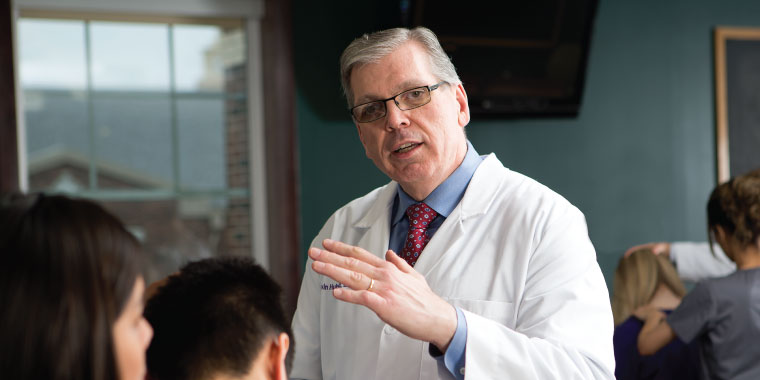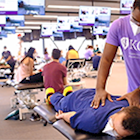Students enter medical school with the goal to help people. They study diseases and cures and visualize themselves saving lives. But sometimes, treatment options are limited and the best that can be done is to help make a patient as comfortable as possible. This can come as a shock to some students, says Kevin Hubbard, DO, MACOI, who teaches palliative care to KCU first-year osteopathic medical students. While some students may have clinical experience prior to entering medical school, few, if any, have experience with palliative care.
Dr. Hubbard, the chair of specialty medicine at KCU, understands this difficult realization. He was in his oncology/hematology fellowship at the University of Texas M.D. Anderson Cancer Center when he began to regularly see patients facing their final days or months. It made him question, what else can we do for patients? It was at this time that palliative care was developing as a distinct specialty. Dr. Hubbard was immediately interested.
“I wanted to be at a patient’s bedside from the beginning to the end.” he says.
Dr. Hubbard did his research and discovered that to become certified in palliative care, 25 percent of your patients must have two years or less life expectancy. A quick look showed that 40 percent of his patients qualified and he went on to earn his certification.
Dr. Hubbard is now the medical director at Kindred Hospice of Independence, Mo., and despite teaching continues to consult with physicians and see patients. From his years of experience, he’s learned a few valuable lessons that he can share with his students.
“You have to put yourself in the patient’s position.” he says. “I ask myself, what approach would I want the physician to take with me? What type of interaction would I want to have?”
“You have to be kind, empathetic and compassionate. You have to listen to your patient because no two people are the same.”
“In these ways palliative care is the pinnacle of osteopathic medicine. We have to look at the whole person. You have to look at their environment. You have to talk to everyone who may notice a change in the patient from physicians to psychologists to the night custodian. Palliative care is interprofessional care and education at its best.”
“Palliative care is an ever-learning experience,” Dr. Hubbard says. “There’s no room for ego and you have to be open to other’s opinions. You have to learn when to treat and when not to. But perhaps most importantly, you have to learn to be vulnerable.”
“The biggest question my students ask is how I manage practicing palliative care without it affecting me.” Dr. Hubbard says. “I ask them why do you think it doesn’t affect me? If it stops affecting you, it’s time to take a step back and ask if you want to continue doing this.”
“You can’t check your emotions at the door. I tell students it’s not shameful to cry or express to patients how you wish things would go better.”
While students may not experience these difficult types of situations until their third- or fourth- year of medical school, or even later like Dr. Hubbard, these early lessons will carry them through their career. Dr. Hubbard’s class is more than just memorizing a text book or searching for cures. It’s about the human experience. It’s about practicing the osteopathic principles of treating the whole patient, mind, body and spirit through the entirety of a person’s life.




(0) Comments